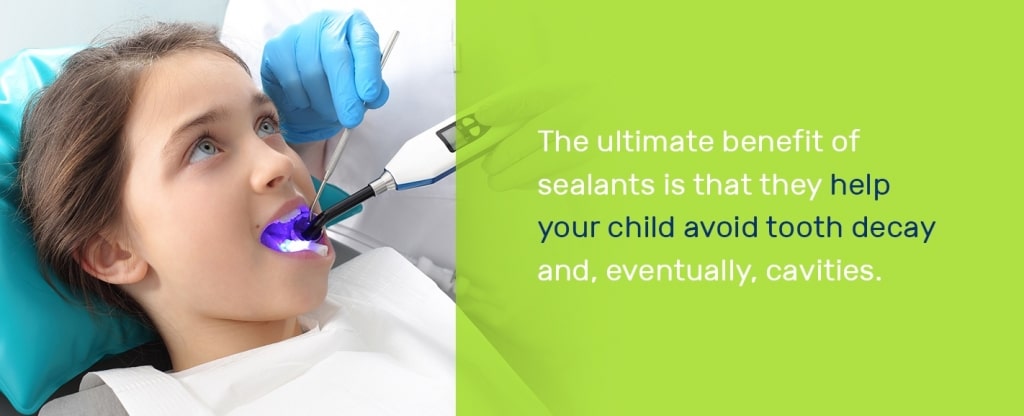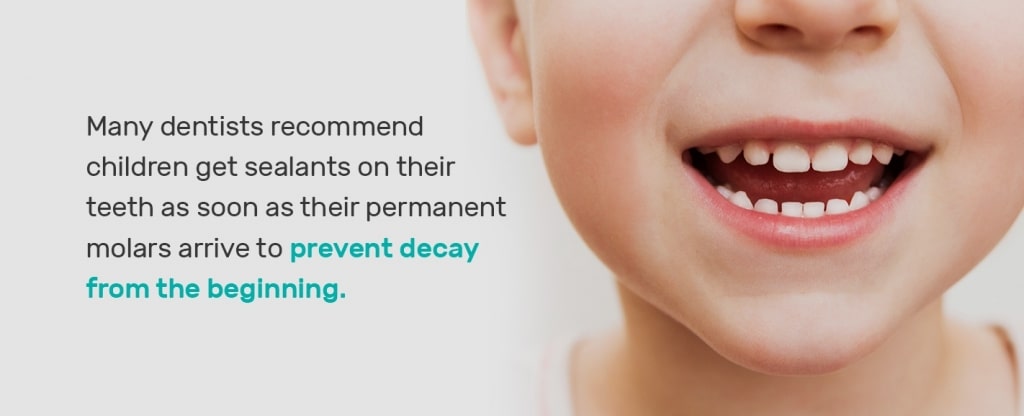Let’s talk about your child and dental sealants.
Although an increasing number of dental professionals stress the need for dental sealants for kids, many parents still aren’t sure what they are or why their child needs them. Like any good parent, you want to do your homework and understand what dental sealants are before you sign off on them. What are they? How are they used? What are dental sealants made of? And what kind of procedure will your child need to put them in place?
We’ve got you covered!
Our guide to sealants is designed to help you make an informed decision regarding your child’s dental health, answer your questions and put your mind at ease.
What Are Dental Sealants?
Take a moment to use your tongue to touch the molars in the back of your mouth. Notice the crevices and pits along them? These are called “grooves,” and they’re highly susceptible to germs and bacteria that build up when food particles — especially sugars — become trapped inside of them. Although regular brushing goes a long way, even the most dedicated of brushers can struggle to clean those grooves properly.
Dental sealants are a thin coating placed over the biting surface of a child’s molars to protect them from the decay. A dental sealant is a thin white or clear resin liquid applied to the surface of a child’s molars with a small brush. The liquid sealant is bonded to the tooth and dries by using a blue LED light, leaving a hard layer of protection. According to the American Dental Association (ADA), that protective layer reduces your child’s risk of cavities by 80%. It’s non-invasive and doesn’t require the use of numbing agents or anesthesia because it isn’t painful. There is also no drilling required, which is also a huge perk!
As a parent, your primary goal is to protect your child. So you’re probably wondering if dental sealants are safe.
Yes, dental sealants are safe and pose minimal risk to your child during the procedure or while they are on their teeth. Because sealants are simply bonded to the tooth, nothing goes inside the tooth, as a filling would. That’s why sealants are a great non-invasive way to help protect your child’s teeth from cavities.
Many parents want to know what sealants are made of. Sealants are made of a medical grade resin, and are similar to composite, or white filling material for when patients have cavities filled. The big difference about sealant material is its runny nature. When applied to the tooth with a small brush, it will easily flow into the micro grooves and crevices of your child’s teeth. Imagine white finger nail polish, but for teeth! Historically, there has also been some concern about BPA in sealants, but most modern sealant materials are BPA-free!
Why Sealants Work
Dental sealants are designed to cover chewing surfaces of the back teeth and help keep out germs, food, and plaque. They essentially form a shield over the grooves in molars and make it easier to keep back teeth clean and protect them from minuscule food particles and bacteria that might otherwise hide in those grooves. By “sealing” out bacteria, food, and other cavities-causing substances, sealants help protect teeth from getting cavities.
What Are the Benefits of Sealants?
Many parents want to know about dental sealants’ pros and cons. The ultimate benefit of sealants is that they help your child avoid tooth decay and, eventually, cavities. Sealants are a preventive procedure, as they help prevent and protect teeth from cavities. In a study that compared school-aged children with and without sealants, children without sealants were three times more likely to have cavities than their peers who had dental sealants. In the same report, the U.S. Centers for Disease Control also noted that dental sealants have the potential to save $300 million in dental costs around the country.

Oral hygiene also has a direct impact on a child’s performance in school. Children who have tooth decay tend to have problems eating and sleeping, which interferes with attendance and performance in school. Although it’s a stretch to say that dental sealants will help your child do better in school, they do have a very direct impact on your child’s health and mental clarity. In other words, dental sealants are a simple way to set your child up for success and prevent small problems from becoming big ones.
When it comes to the downsides of dental sealants, there really aren’t any. Occasionally, they can chip or wear away, requiring repair or replacement, but this isn’t very common and isn’t a big deal when it happens. Another downside about sealants is they don’t last forever. Normal wear and tear will cause sealants to thin out over time. However, when done properly, sealants can last a minimum of 3-5 years, even up to 10!
Fluoride vs. Dental Sealants
Many parents mistakenly believe that fluoride treatments during dental hygiene and check-up visits are just as effective as dental sealants. This isn’t true. Although fluoride treatments are an essential part of protecting your child’s teeth, they are most effective when used in tandem with dental sealants.
In an ADA study comparing children who only received fluoride compared with children who received fluoride treatments and dental sealants, the children who were given both were 73% less likely to present with cavities later.
Fluoride helps to remineralize and strengthen all surfaces of enamel. Dental sealants, however, alter the anatomy of the teeth, making grooves less deep, and therefore, less likely to retain plaque and food particles.
How Do Dentists Apply Sealants?
Applying dental sealants is a fast and painless procedure. When you and your child arrive at the dentist for their sealant appointment, they’ll be placed in a chair in a regular exam room. There is no drilling and no numbing required with dental sealants. Can can expect a relatively fast and easy procedure:
- Clean the teeth being sealed with a polishing brush and pumice (gritty toothpaste).
- Dry the teeth and isolate them from any saliva from the tongue and cheeks using a small cotton roll or triangular intraoral cheek shield called a “dry angle.”
- Apply an etching solution to the surface of the tooth being sealed to disinfect and prep the tooth for better sealant adherence.
- Rinse off the etching solution and dry teeth again.
- Paint on a thin bonding layer, followed by the sealant, directly onto the surface of the tooth, covering the enamel.
- Use an LED blue light to help the “cure” the sealant. This allows for faster application, as it hardens and bonds the sealant to the tooth surface.
After the sealant is hardened, your child’s appointment will be complete. Each tooth being sealed takes about just one minute! There are no restrictions following sealants, patients can eat and drink right away, and can return to school immediately after.
How Long Do Dental Sealants Last?
Dental sealants for a child are designed to protect your child’s teeth for a minimum of 3-5 years, even up to 10 years, if they’re well maintained. During your child’s regular dental checkups, the dentist will check the sealants to ensure they are still in place and haven’t cracked or worn away. If they are damaged, then they can be quickly and easily repaired.
Sealants tend to “fail” or fall off easily if the tooth is not impeccably clean or dry as the sealant is being applied. For wiggly patients, or patients with an active tongue or sensitive gag reflex, the application process can be more challenging, and your dentist may delay application by 6-12 months to allow for better cooperation if necessary.
Does Insurance Cover Sealants?
Many insurance plans do cover dental sealants. Most insurance companies consider sealants to be a “preventive” procedure, which means that they are usually covered at the highest level, usually 80-100% of the total cost. Check with your insurance provider to determine the scope of their coverage, as some insurance companies put age limits on sealants.
Who Should Get Sealants?
Dental sealants are an important preventative measure designed to give your child’s smile every possible advantage. Many dentists recommend children get sealants on their teeth as soon as their permanent molars arrive to prevent decay from the beginning. Applying dental sealants has become the standard of care among most pediatric dentists.

The first set of permanent molars — also known as “6-Year-Old Molars” — typically arrive between ages 5 and 7. When your child’s next set of molars — “12-Year-Old Molars” — arrive later, your dentist can apply additional dental sealants. These second molars usually come in between 11 and 14 years of age.
Although not as common, some dentists will recommend dental sealants for young children whose “baby” molars have significant grooves or pits in them. Although these teeth will eventually fall out between ages 10-12, it’s still essential to protect your child’s oral health early on and prevent problems that may plague them later on.
Pediatric Dental Sealants
At Sprout Pediatric Dentistry & Orthodontics, we’re privileged to walk beside children and their parents throughout their early years. Our goal is to teach proper oral hygiene habits and encourage the application of important preventative measures — such as pediatric dental sealants — that will protect a child’s smile for years to come. But we don’t stop at cleanings and dental sealants. Sprout Pediatric Dentistry & Orthodontics is happy to combine pediatric dentistry with orthodontics, providing a comprehensive oral health practice that serves children at all ages and stages.
Schedule an appointment today!

Dr. Dana grew up in Portland and went to Temple University in Philadelphia, PA for dental school. She then moved to Anchorage, AK for her residency in Pediatric Dentistry. Dr. Dana takes a holistic approach to pediatric dentistry & is able to use her own parenting experience to sympathize and understand each family’s unique dynamic.



